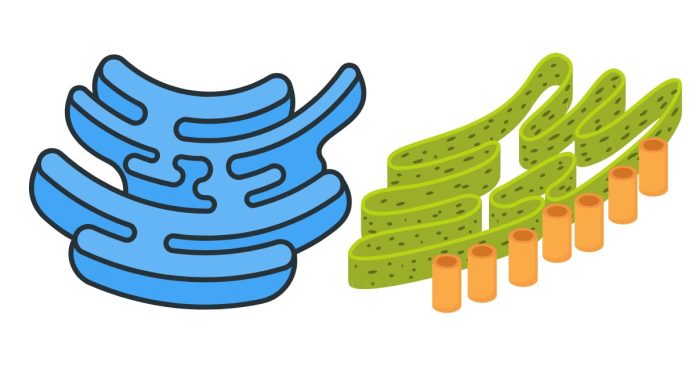The endoplasmic reticulum (ER) is an essential organelle in eukaryotic cells that plays a crucial role in the synthesis, folding, modification, and transport of proteins and lipids. The rough endoplasmic reticulum (RER) and the smooth endoplasmic reticulum (SER) are two distinct types of ER, each with specific functions and structures. Let’s dive into how they differ from one another.
- Surface Structure
Rough Endoplasmic Reticulum (RER): The RER gets its “rough” appearance because it is studded with ribosomes on its cytoplasmic surface. These ribosomes are responsible for protein synthesis, making the RER the primary site for producing proteins, especially those that are destined for secretion, incorporation into the cell membrane, or use in lysosomes.
Smooth Endoplasmic Reticulum (SER): The SER, on the other hand, lacks ribosomes on its surface, giving it a smooth appearance. Its smooth surface is key to its function in processes like lipid synthesis and detoxification.
- Function
Rough Endoplasmic Reticulum (RER): The main role of the RER is in protein synthesis and quality control. After proteins are synthesized by the ribosomes, they are transported into the lumen of the RER for folding and modification. The RER also plays a role in synthesizing proteins that will be secreted from the cell or incorporated into the cell membrane.
Smooth Endoplasmic Reticulum (SER): The SER is involved in a variety of other functions, such as lipid synthesis, detoxification, and carbohydrate metabolism. For example, in liver cells, the SER is involved in breaking down toxins, while in muscle cells, it stores calcium ions that are crucial for muscle contraction.
- Location and Abundance
Rough Endoplasmic Reticulum (RER): The RER is often found in areas of the cell where protein production is particularly active, such as in secretory cells, like those of the pancreas or salivary glands.
Smooth Endoplasmic Reticulum (SER): The SER is found in cells that are involved in lipid metabolism or detoxification, such as liver cells or cells involved in hormone production. The SER is also abundant in muscle cells, where it is referred to as the sarcoplasmic reticulum.
- Presence of Ribosomes
Rough Endoplasmic Reticulum (RER): Contains ribosomes attached to its membrane, which are essential for protein synthesis.
Smooth Endoplasmic Reticulum (SER): Does not contain ribosomes, which is why its surface appears smooth under a microscope.
In summary, the key difference between the rough endoplasmic reticulum (RER) and the smooth endoplasmic reticulum (SER) lies in their structure and function. The RER is studded with ribosomes and primarily involved in protein synthesis and modification, while the SER lacks ribosomes and is responsible for lipid synthesis, detoxification, and calcium storage. Both types of ER play vital roles in maintaining cellular functions and are essential for the overall health of the cell. Understanding these differences helps illuminate the diverse and specialized functions that different regions of the cell perform.


